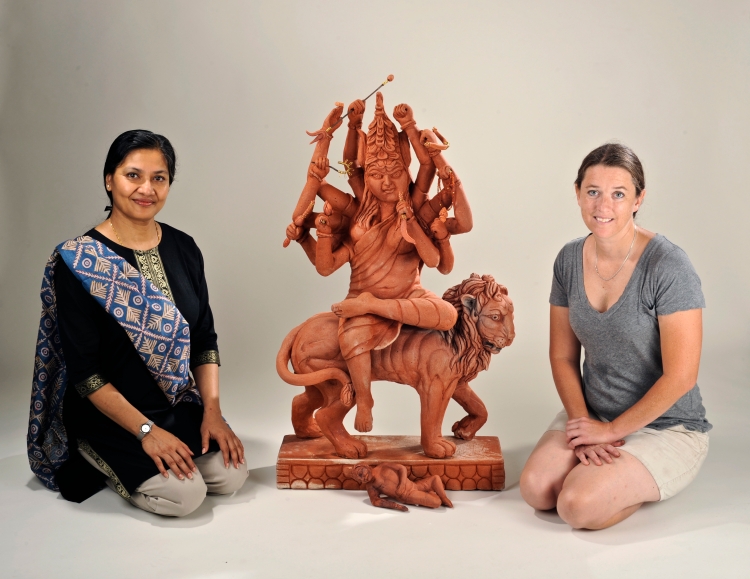Below is the content of both articles, (separately published and duly noted) in their entirety with corresponding photos featured in each article. A caveat: This format is not the exact manner in which the article appears in Neue Keramik Magazin, but how I put the content together on my blog for easier reading.
A First in Cultural Bridging: The Saraswati Project
(First article published in Vol. 5/2013 of a leading German Journal on Ceramics Neue Keramik Magazin, pg. 66. The article is published in English and German)
Doors Opened:
In the late part of 2010, I was introduced to a member of the Kansas City Bengali Association at my office where I teach Ceramics at Johnson County Community College in Overland Park, Kansas. The member of the local Association was Mrs. Bhaswati Ray, who told me she had come looking for advice or a means to make a Hindu deity for the Saraswati Puja in February of 2011. Saraswati is the goddess of knowledge, music, arts and science, and one of the foremost goddesses in the eastern Indian state of Bengal.
My friendship with Ray began after I shared accounts of my post-graduate travels in India during the late 1990’s to go “temple-hopping” and to pursue my longtime interest in Indian sculpture, which had been influential in the development my own figurative work. For nearly two decades, I had been enamored by the twisted and contorted figures that adorned historical Hindu temples whose main purpose served as a visual narrative to those who could not read. After we spoke, I enthusiastically told Ray I would make the piece. At first she appeared both shocked and relieved. I then realized that it might not be appropriate for me, a non-Hindu, to make a ceramic sculpture for a religious ceremony. I voiced my concerns to Ray, but she seemed more concerned about the time frame to make the piece than whether I was qualified. In Bengal, most deity sculptures are made out of terracotta over an armature that is never fired. Historically, sedimentary or riverbed clay has been so widely used in Bengali art and architecture because it is a ubiquitous material. The state of Bengal is comprised largely within the Gangetic floodplain, an area very rich in clay soils. During pujas, unfired deities are paraded through crowds of pilgrims in the streets to the temple where they receive blessings by Brahmin priests. The sculptures become “transformed” in the process from a material thing into the embodiment of the deity itself. Following the ceremony, the sculptures are carried down to the Ganges, where they are immersed in the holy river and allowed to disintegrate, a symbol that the cycle of life is flowing and not stagnant. Such practice has taken place for thousands of years by devout Hindus, but never a non-Hindu like myself.
Beginning Project #1: The Saraswati Project
There were only two months to create and fire Saraswati, which meant it had to be smaller. Over the next few weeks, I met the president of the KCBA, Debashis Haldar. I was given some parameters to follow to insure the piece would fall within proper religious protocol. It was expressed that the figure had to be light in color, carrying her symbols of the arts and wisdom.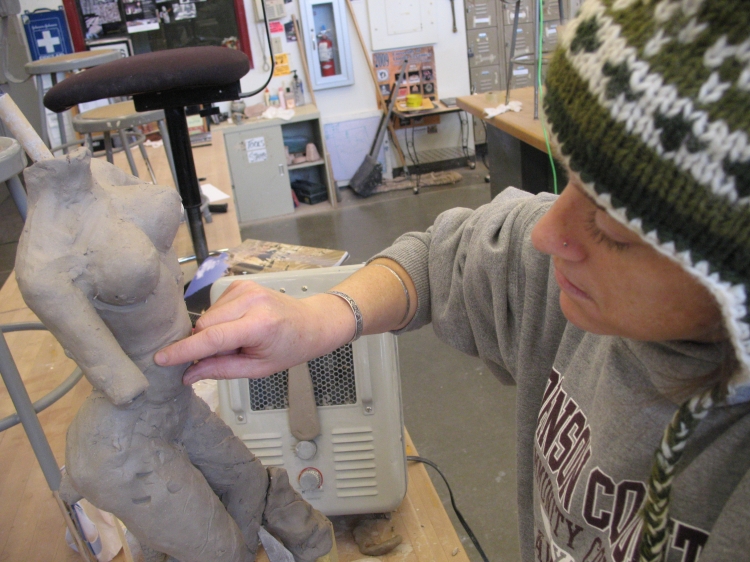
above: refining detail
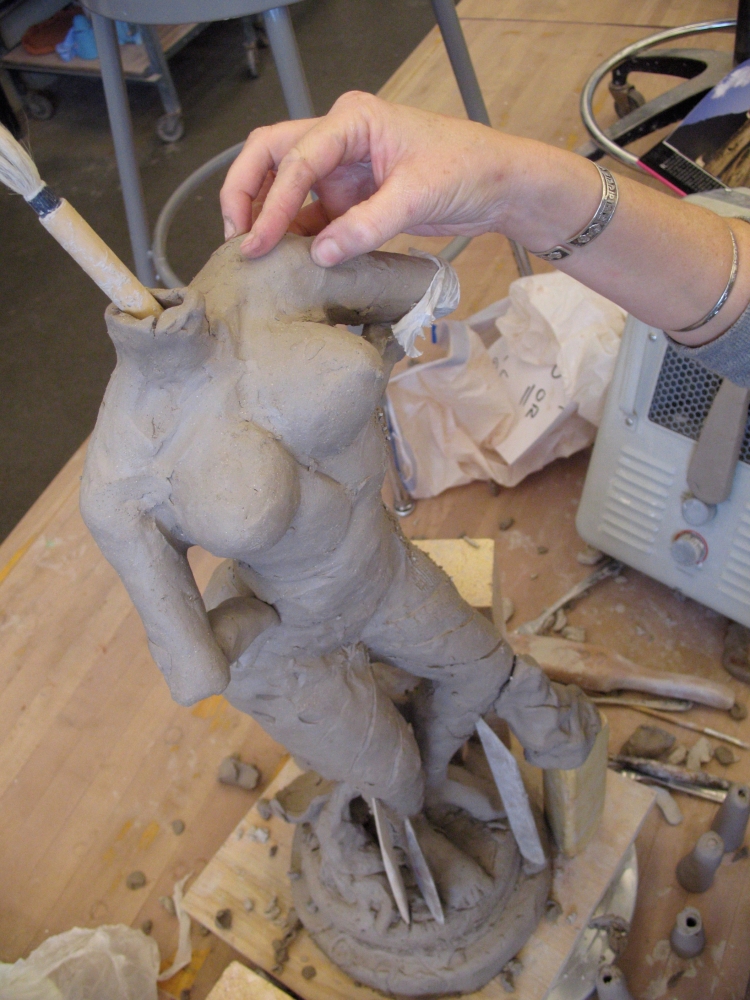 above: moulding the figure; below: adding clothing
above: moulding the figure; below: adding clothing
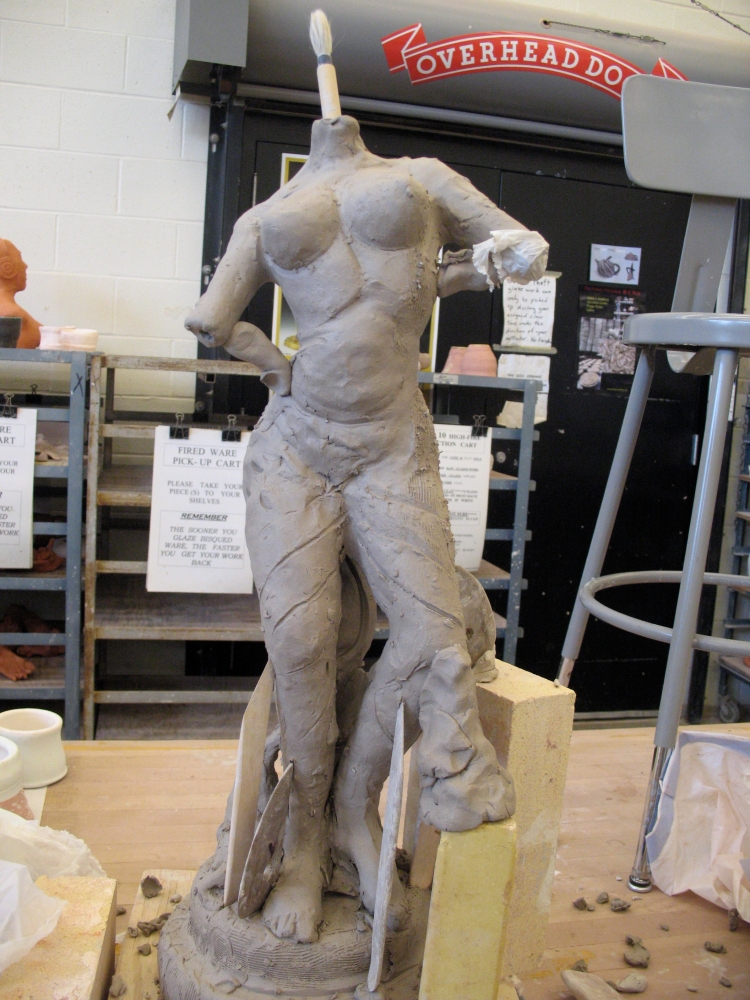 Saraswati using porcelainous stoneware that I use with my larger figurative pieces. I proportioned her out of be about two feet in height, using hollow parts put together. I did a lot of reading and studying on her to get to know my subject before I commenced moulding the basic elements, such as the base and general pose of the piece.
Saraswati using porcelainous stoneware that I use with my larger figurative pieces. I proportioned her out of be about two feet in height, using hollow parts put together. I did a lot of reading and studying on her to get to know my subject before I commenced moulding the basic elements, such as the base and general pose of the piece.
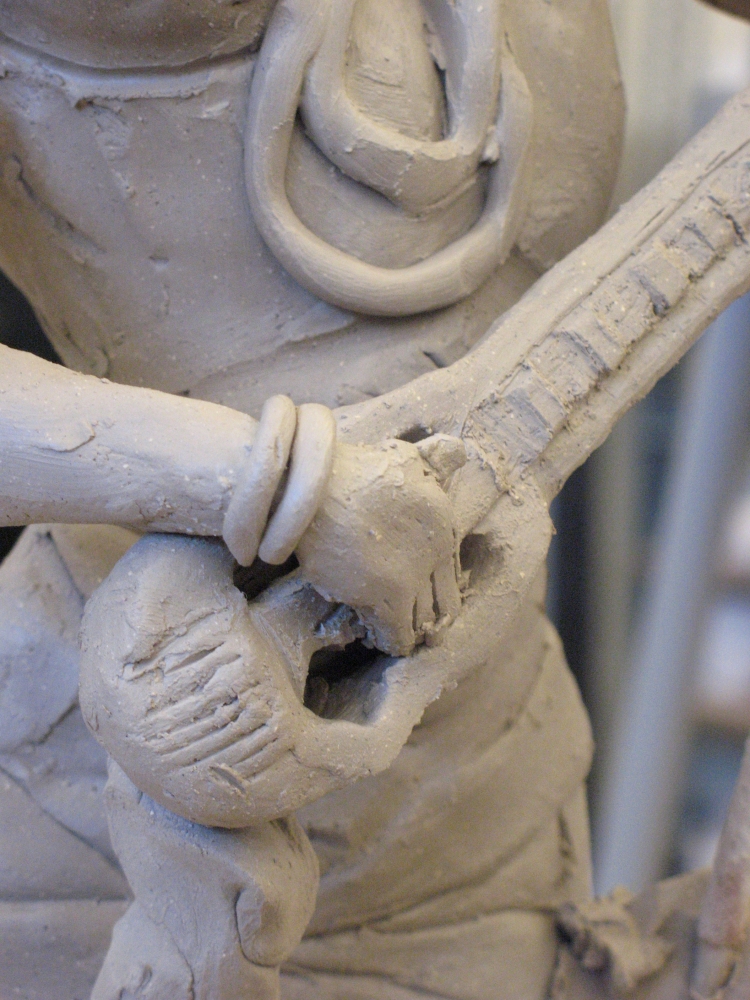 above: rough detailing of vina
above: rough detailing of vina
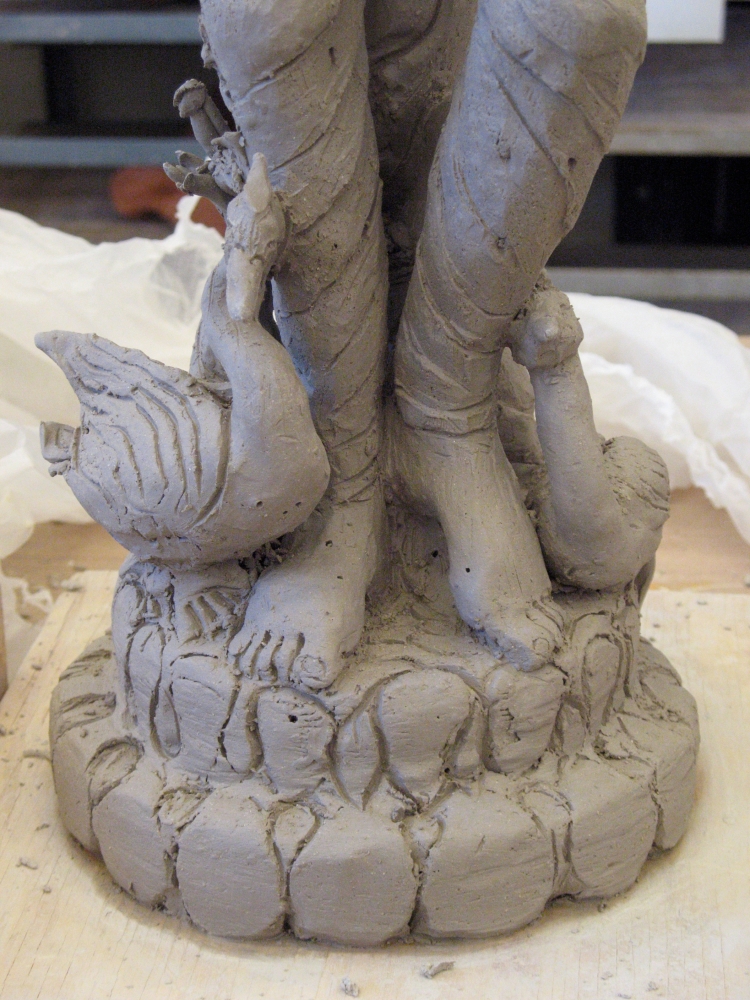 above:Base detail of Saraswati
above:Base detail of Saraswati
Saraswati’s Transformation
The puja ceremony was a very moving and intimate experience for me. Even though I had visited a number of Hindu temples in India as well as a few in the U.S., I had never been invited to be part of such a sacred rite. I was surprised that it got the attention of Hindus and non-Hindus alike, who attended the ceremony and approached me. During the event and in the weeks that followed, I was interviewed by the local newspaper and by Vern Barnett, an interreligious leader for CRES (The Center for Religious Experience and Study) in the community who requested that I give an interview to put in his website. During the puja, I was asked to stand next to the sculpture and accept the blessing of a Brahmin priest. He did so, and then blessed the sculpture by marking it with pigment and adorning it with a special saffron cloth. Members of the congregation then told me, “It is no longer a sculpture; she is now a transformed goddess.”
Above and below: Formal photos of Saraswati
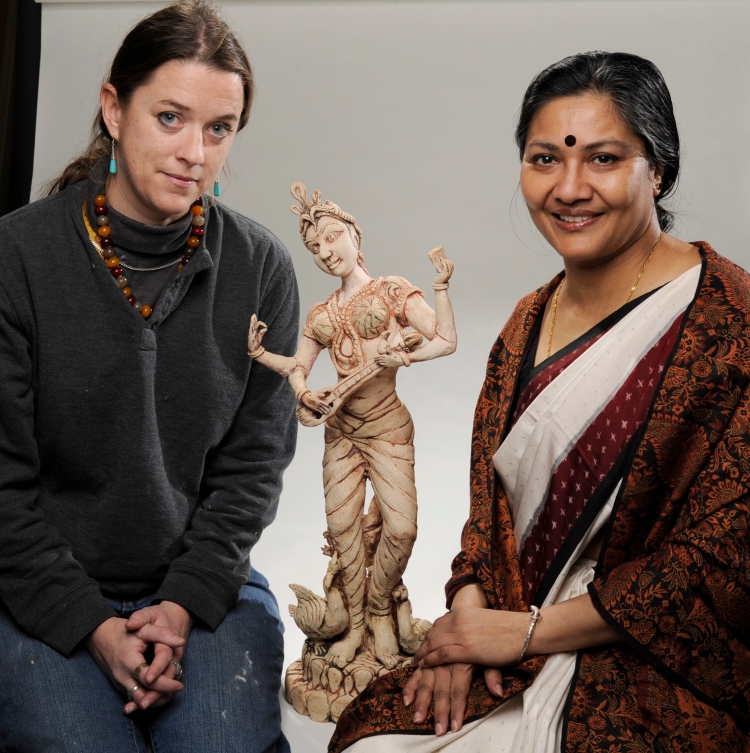 above: Gascogne and Bhaswati Ray
above: Gascogne and Bhaswati Ray
Second article features: The Durga Project
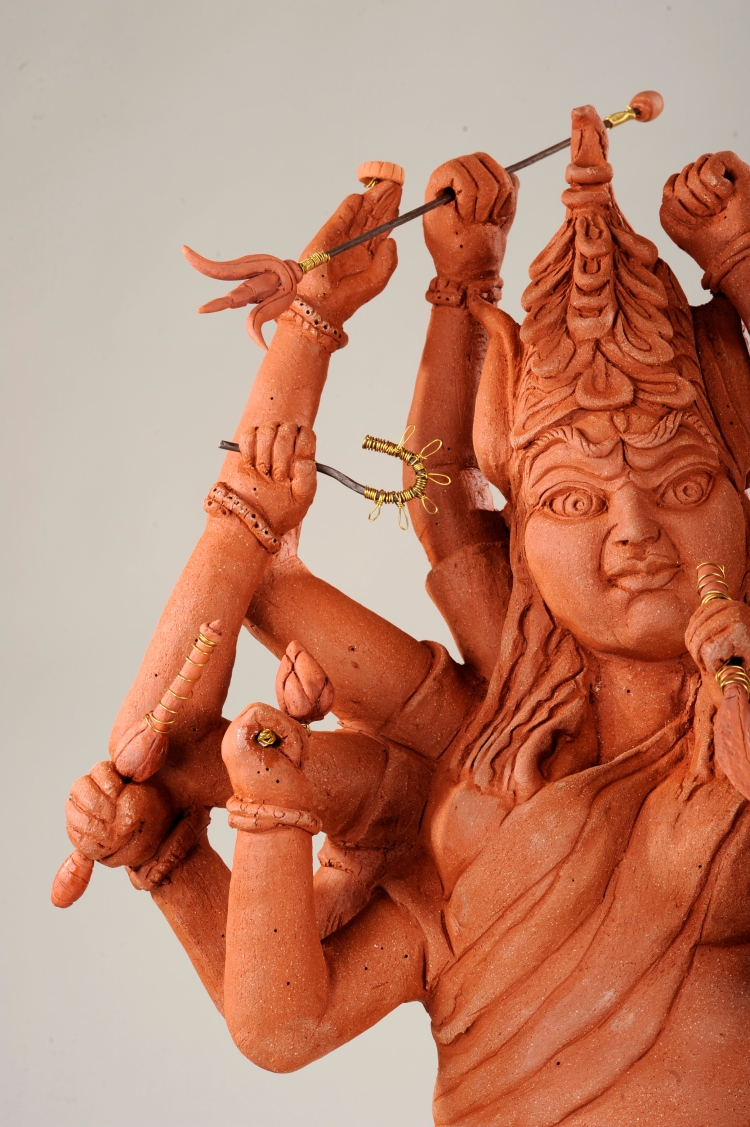 (The second article featured in Vol. 1/2014 of a leading German Journal on Ceramics Neue Keramik Magazin, pg. 62. The article is published in English and German)
(The second article featured in Vol. 1/2014 of a leading German Journal on Ceramics Neue Keramik Magazin, pg. 62. The article is published in English and German)
Several more local articles covered the unusual and unprecedented Saraswati Project . A month or two afterwards I was again approached by members of the KC Bengali Community. The asked me to make a Durga, for the largest and most auspicious religious ceremony to Bengali Hindus. I was given months of lead time, and was given the go-ahead to begin construction out of terracotta. The Durga Project would be the largest, most complicated multi-sectional piece I had ever created.
Building Durga
The base alone for Durga and her lion consisted of 75 pounds of clay, which I partially hollowed out and carved after it set up over a week.
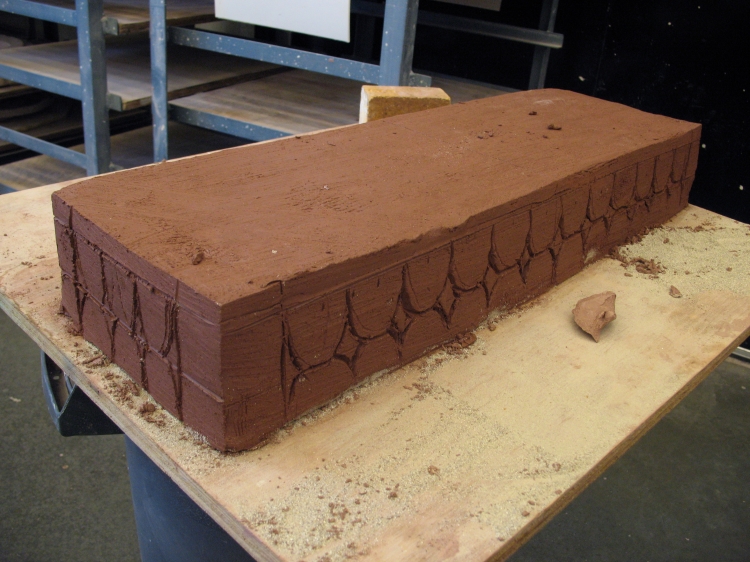 above: the 75 lb. base of the sculpture
above: the 75 lb. base of the sculpture
Secondly, I built the body of the lion upside down, using a cardboard tube that I wrapped a slab around, letting stiffen before removing the tube. Afterwards, I commenced making the legs of the piece, by inserting a dowel rod through large solid coils of clay. Later, I flipped the lion’s body upright so I could begin building Durga and determine her proper proportions and positioning.
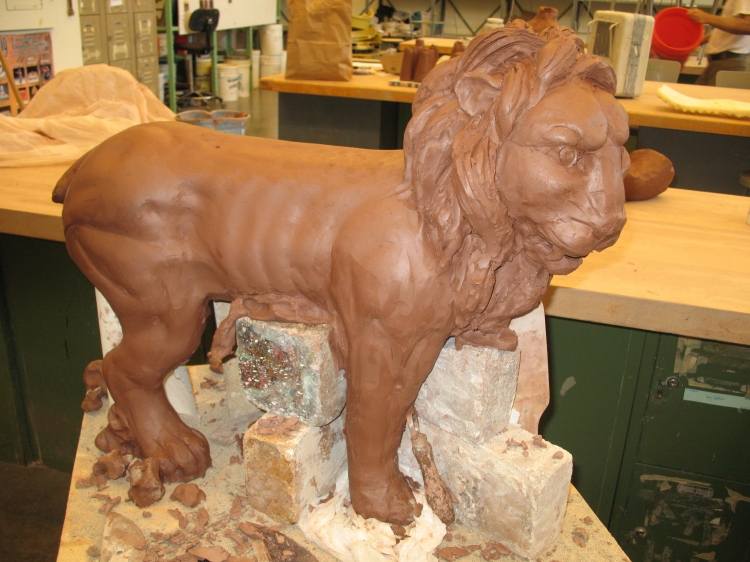 above: the head of the lion added with support;
above: the head of the lion added with support;
below: the lower half of Durga added to the lion’s back
The lion remained very heavy after it was flipped upright, but I was able to refine the musculature and to visualize how Durga would be positioned. I started her bottom half, unattached, on the lion’s back. The weeks that followed were spent doing an intense amount of detailing and proportioning to insure the piece would be balanced and symbolically correct.
 above: parts of the the ten armed figure; below: refining the details once together
above: parts of the the ten armed figure; below: refining the details once together
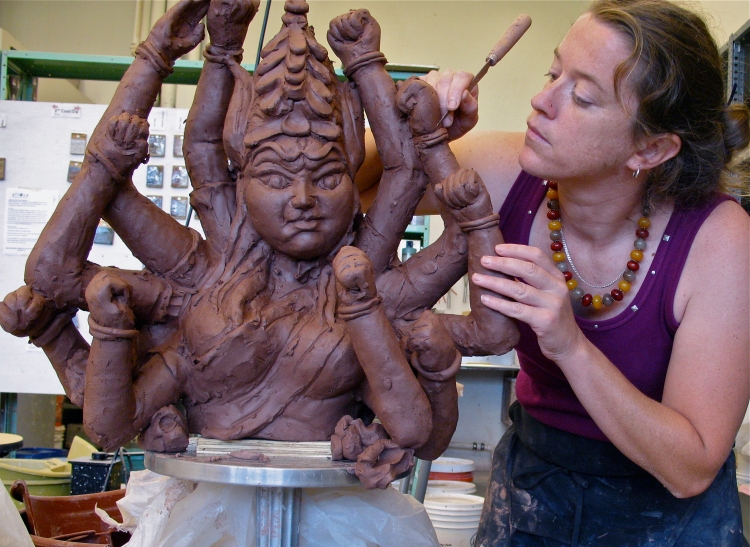 Her ten arms were each individually made and positioned with the corresponding weapon or sacred object. Each of the sacred objects was researched and then created with mixed media, mainly clay and brass.
Her ten arms were each individually made and positioned with the corresponding weapon or sacred object. Each of the sacred objects was researched and then created with mixed media, mainly clay and brass.
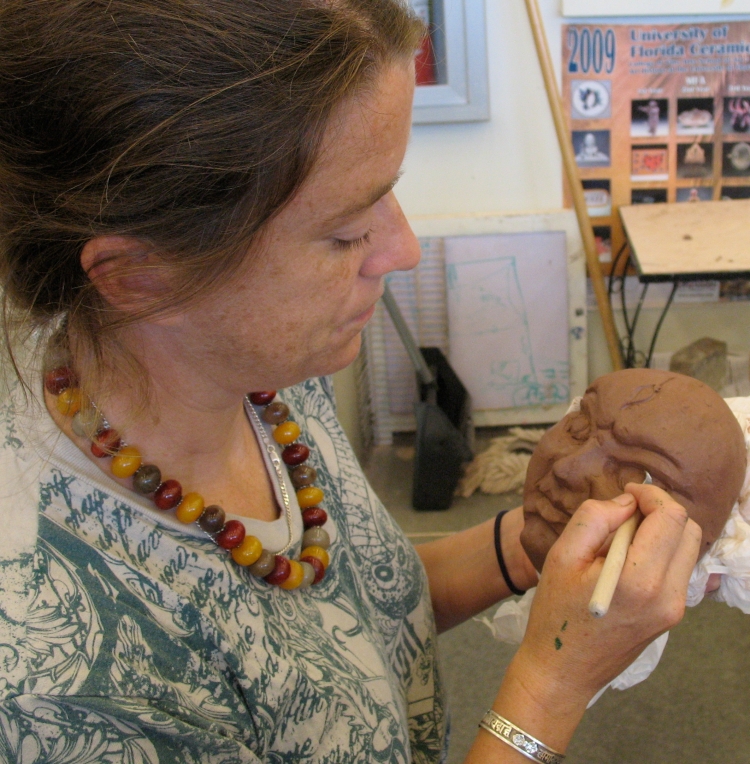 above: sculpting Durga’s face;
above: sculpting Durga’s face;
below: detailing the face of the lion
Firing a multi-part Sculpture
Once the figure was completed, I separated the statically side-seated figure from the lion, and separately loaded both of them at leather hard into gas cart kilns where they dried out for three weeks. Once the pieces had reached bone dry, the firing was allowed to candle for three days and then fire for two days.
Durga Serves a Different Purpose
The ceremony, held at a local high school, was much larger than the Saraswati puja, comprised of local vendors, a huge langar, or lunch, following the blessings, and various bustling activities for the kids. There were two Durgas, as well as other members of the Hindu Pantheon, all richly adorned. The purpose of my sculpture this time was not so much to be a part of the sacrament, but educational. It served as a reminder to Bengalis about the importance of interfaith tolerance and outreach, as well as cultural education, and the important use of terracotta as a material in Bengali Art. These aspects were addressed by a local public radio station during the event. In the final night of the festival, I was presented with the first ever Interfaith Award at a hugely attended presentation in the school auditorium. In a world so steeply divided on religious and cultural differences, I was humbled to be a small yet positive part of mutual change in the status quo through donating “The Saraswati Project” and “The Durga Project” to the KCBA.
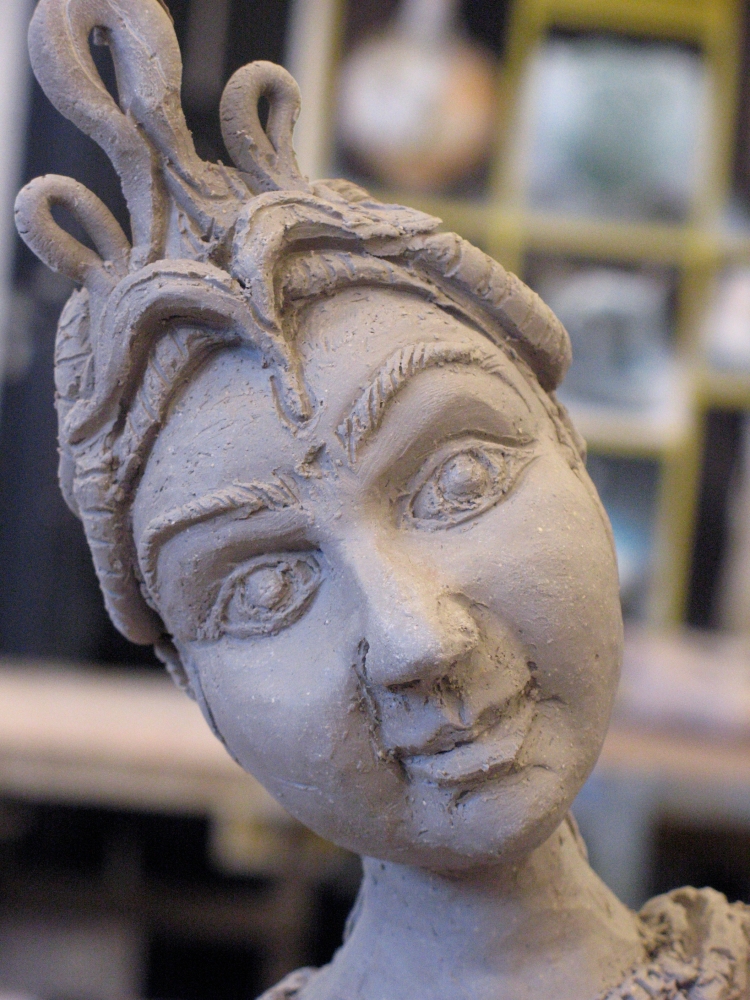
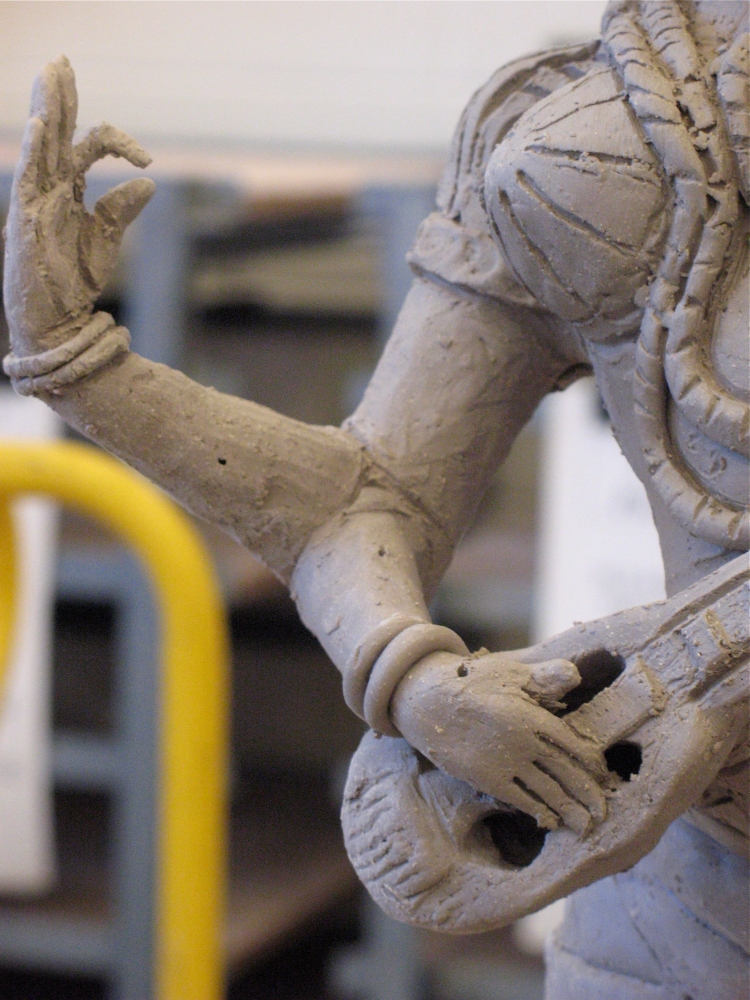
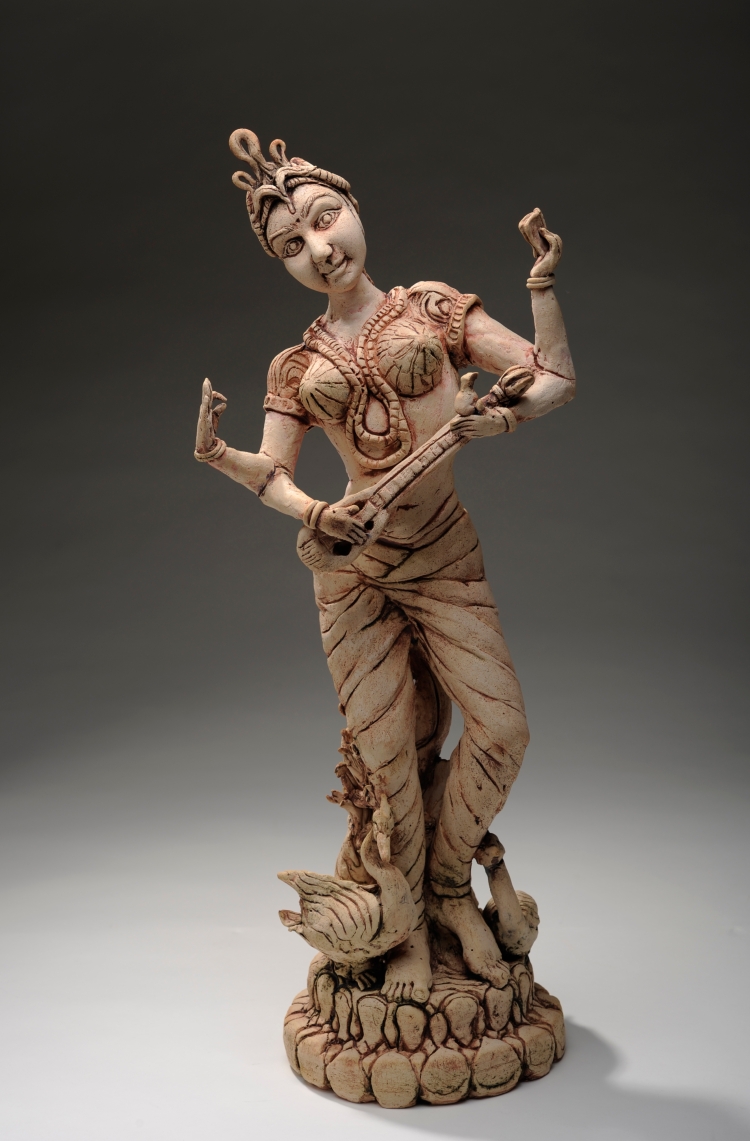
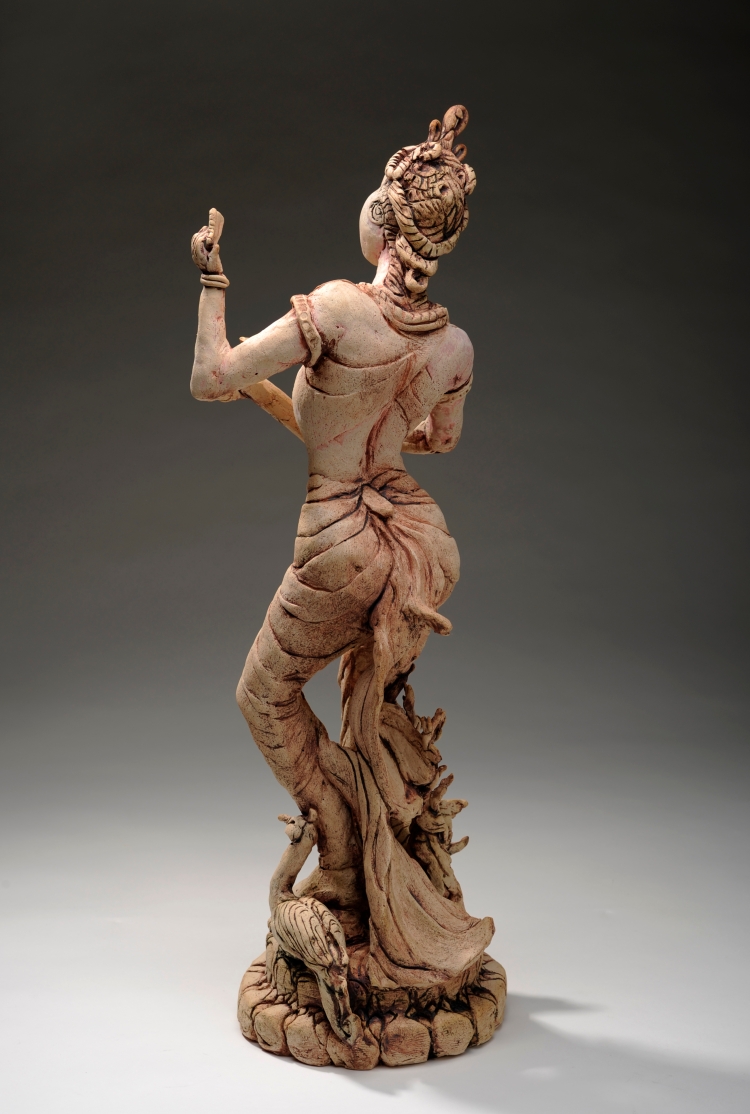
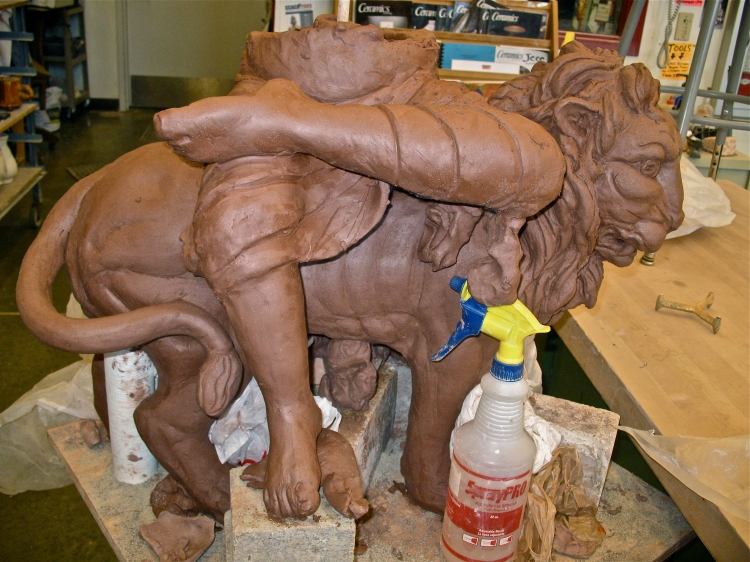
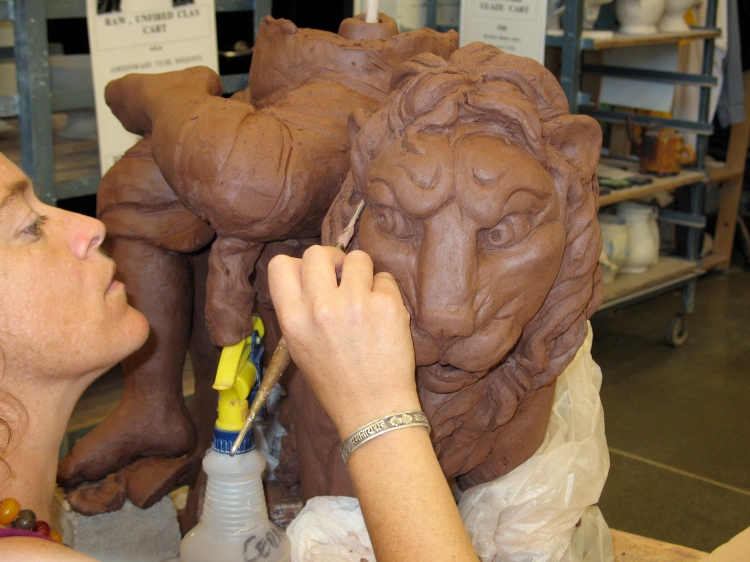
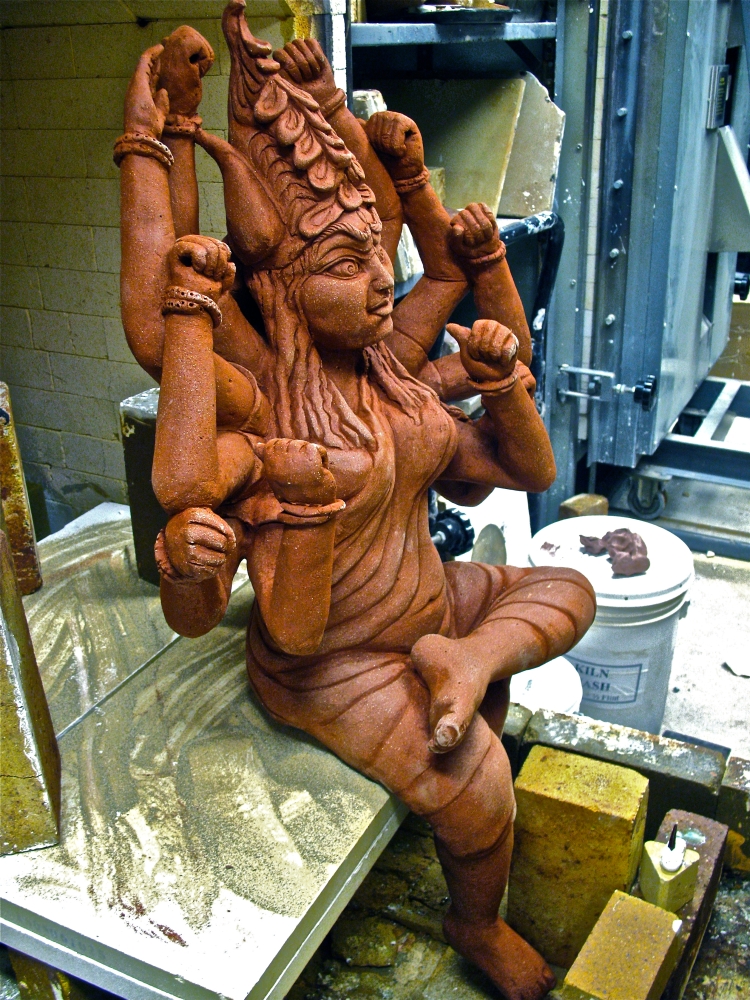
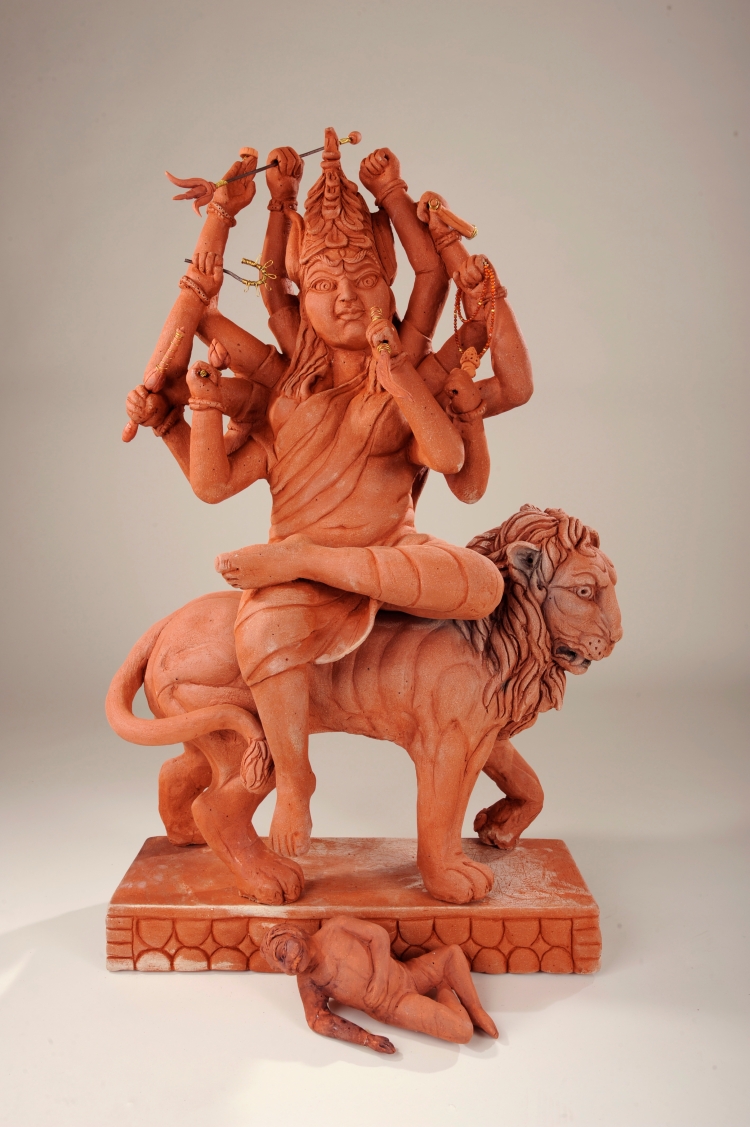 above: Durga with weapons
above: Durga with weapons